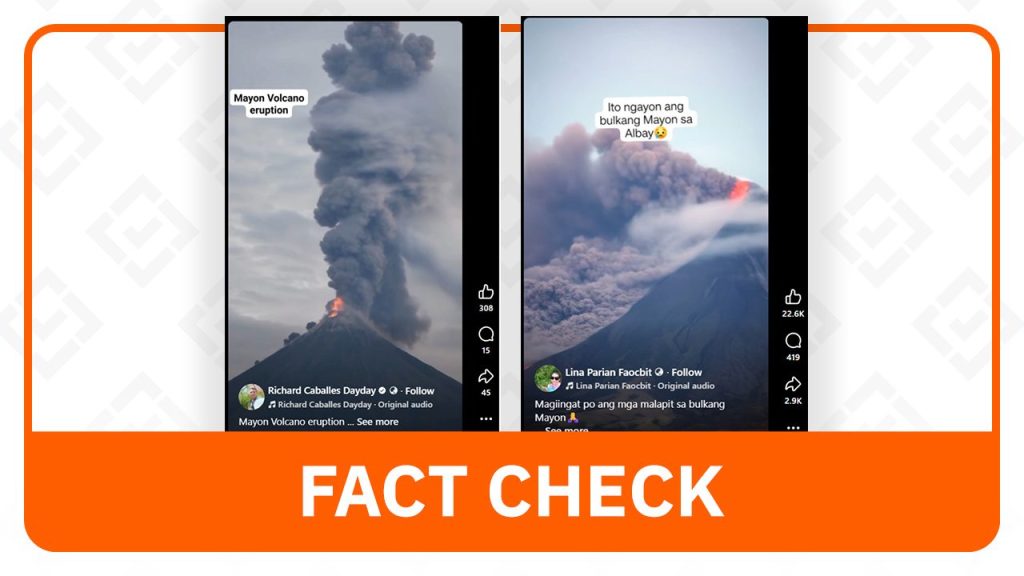Listen to the article
No eruption has occurred at Mayon Volcano in the past month, despite viral social media claims showing apparent ash plumes spewing from the iconic Philippine landmark, according to the Philippine Institute of Volcanology and Seismology (Phivolcs).
Multiple Facebook reels circulating since late October have falsely portrayed an ongoing eruption at the perfectly cone-shaped volcano in Albay province. One video posted on October 22 has amassed 1.8 million views and thousands of shares, with text claiming, “This is Mayon Volcano now here in Albay.” A second video posted on October 28 makes similar claims and has gained over 22,000 views.
The videos have sparked unnecessary concern among viewers, with comments expressing fear for residents near the volcano. “It’s scary, Ma’am. Stay safe there,” wrote one commenter, believing an eruption was actually taking place.
However, according to Phivolcs’ October 30 volcano bulletin, Mayon remains under Alert Level 1, indicating only low-level unrest. While the volcano is currently calm, authorities note that hazards such as sudden steam-driven eruptions, rockfalls, or lahars during heavy rainfall remain possibilities even at this alert level.
Image analysis suggests the viral videos likely repurposed photographs from Mayon’s January 2018 eruption. A reverse image search revealed striking similarities between frames in these videos and documented photos taken on January 16, 2018, by European Press Photo Agency photographer Zalrian Sayat.
Digital forensics also point to potential manipulation. When analyzed with AI detection tools, screenshots from the videos showed significant probabilities of artificial intelligence enhancement. One AI detector, Sight Engine, flagged a screenshot as 78% likely to be AI-generated, while another video showed a 59% probability of AI manipulation.
The same footage has appeared on TikTok, where the platform has automatically labeled it as “AI generated” content that “may return results that are not relevant” and “does not represent TikTok’s views or advice.”
Mayon Volcano, located approximately 330 kilometers southeast of Manila, is one of the Philippines’ most active volcanoes and a significant tourist attraction due to its nearly symmetrical cone shape. Its 1814 eruption remains the most devastating in its recorded history, both in terms of casualties and the extent of volcanic hazards from the crater.
The volcano did experience a phreatic or steam-driven eruption in February 2024, which produced a plume reaching 1,200 meters (1.2 kilometers) in height, but no significant activity has been documented since then.
This is not the first time false claims about volcanic eruptions have circulated on social media in the Philippines. Fact-checking organization Rappler has previously debunked similar misinformation about volcanic activity in the country.
The spread of such false information about natural disasters highlights the ongoing challenge of misinformation on social media platforms, where dramatic imagery and claims can quickly gain traction despite being inaccurate. Officials continue to encourage the public to obtain information about volcanic activity only from official sources like Phivolcs rather than unverified social media posts.
Verify This Yourself
Use these professional tools to fact-check and investigate claims independently
Reverse Image Search
Check if this image has been used elsewhere or in different contexts
Ask Our AI About This Claim
Get instant answers with web-powered AI analysis
Related Fact-Checks
See what other fact-checkers have said about similar claims
Want More Verification Tools?
Access our full suite of professional disinformation monitoring and investigation tools




5 Comments
It’s disappointing to see misinformation spreading about Mayon Volcano’s activity status. Maintaining accurate, real-time monitoring and communication from official sources is crucial for public safety, especially for volatile natural phenomena like volcanoes. Glad the situation seems stable for now.
Mayon Volcano’s iconic cone shape is quite striking, but false alarms about eruptions are problematic. Verifying facts and not spreading misinformation is so important, especially for natural hazards that could impact local communities. Glad the authorities are closely monitoring the situation.
Kudos to the fact-checkers for debunking the misleading viral videos about Mayon Volcano. Volcano science and risk assessment require nuance – good to see the authorities providing level-headed updates. Even without an active eruption, the potential hazards deserve vigilance from nearby residents.
Interesting to hear that the viral videos showing Mayon Volcano erupting are actually old footage from 2018. It’s important to verify information, especially about natural disasters, before spreading panic online. Good to know the volcano is currently calm, though hazards like steam-driven eruptions are always possible.
Appreciate the Phivolcs update confirming no recent eruption at Mayon Volcano. Volcano monitoring and accurate information are crucial, especially in regions prone to seismic activity. Glad the situation seems stable for now, but vigilance is still warranted given the potential risks.